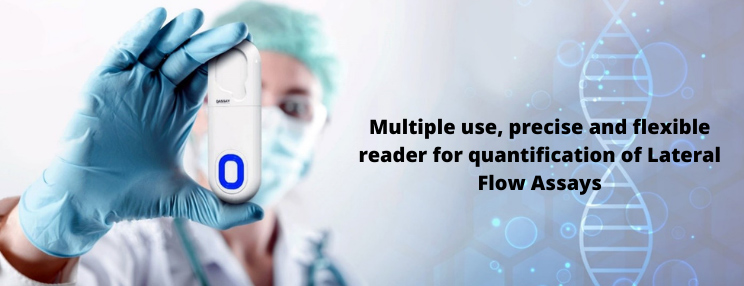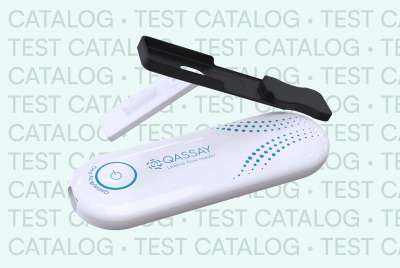The usage of lateral flow tests for various applications has increased significantly in the last years. This surge of interest has created a need for switching from qualitative test result interpretation by a human to quantitative reading that can generate workable data.
Automated lateral test readers represent a significant step ahead in processing test results optimally with the purpose of making better healthcare or environmental decisions.
What are lateral flow readers?
Lateral flow readers (LFRs) are devices for reading and interpreting the results of lateral flow tests or lateral flow assays (LFA)/immunoassays (LFIA). These tests are used to confirm or exclude the presence of a target analyte. The analyte can be a pathogen or a biomarker, either human or animal, or a contaminant.
Lateral flow readers were developed in the mid 1990’s in tandem with advances in digital photography. They became commercially available in the early 2000s and slowly paved the way for today’s small, handheld readers employed for individual point-of-use lateral flow tests.
Lateral flow assays (LFAs) have experienced a new rise in popularity since the Covid-19 pandemic. This type of test had been widely used before for pregnancy tests, which already have a history of more than three decades. Lately, the increase in lateral flow assay testing in various fields has generated a need for more accurate, quantitative reading techniques that integrate reliable data storage and transmission methods. For instance, manufacturers are joining forces to improve reading accuracy by introducing spectral sensors lateral flow readers to raise standards in the point of care industry (Qassay and OSRAM).
How does a lateral flow reader work?
Lateral Flow Reader technology is evolving at a rapid pace. Today’s LTRs are highly flexible, versatile and customizable, easy to read, and can use any lateral flow assay.
Lateral flow assays use three elements to produce results: a nitrocellulose membrane, colored nanoparticles, and antibodies.
When a sample is added to the test, it flows along the test device onto an absorbent pad, passing through a conjugate pad. Some pads contain a filter to ensure a controlled flow of the sample.
The conjugate pad includes conjugated labels and antibodies which bind to the target if present, while continuing to migrate along the test.
The intensity of the colored line indicating the test result depends on the quantity of the present target. A lateral flow assay can yield quantitative results when the test is combined with a reader, thus determining target concentration. A LFA without a reader will be able to offer qualitative results only (whether the agent is present or not); assessing the colored line intensity by a human reader carries a large degree of subjectivity.
In other words, lateral flow assays alone are intended to operate on a purely qualitative basis. Readers, on the other hand, enable the use of quantitative tests, offering additional features that enhance the results of the test, with the two most important being:
- Determining how much analyte is present in the sample by measuring the intensity of the test line. Readers employ image processing algorithms that are specially designed for a particular test type and medium;
- Collecting and sending test results data to third parties, where it can be processed and used to diagnose in a faster and more accurate manner.
What are the benefits of lateral flow tests?

Error control
LFAs include a control line to confirm the test is working properly and one or more test lines. The presence of the control line indicates that the result is reliable, thus eliminating errors.
Intuitive use
Lateral flow tests have intuitive and easy to use protocols, which means that anyone can operate them with minimal training. The reading is conducted visually by the person administering the test or with assistance from a reader technology device.
Can be used in various settings
LFAs can be performed by anyone from patients to health care professionals, which means they can be administered anywhere: in laboratories, in clinics, at home, on the field.
High accuracy
The results of LFA tests have a similar level of accuracy compared to PCR tests analyzed in lab settings. For instance, for rapid tests used to detect the Covid-19 infection, tests’ accuracy levels can exceed 90%. Lateral flow readers are accurate enough to identify low analyte detection levels.
More affordable than PCR tests
Lateral flow tests are an affordable alternative to PCR tests, guaranteeing a high level of sensitivity and specificity. They have been an essential tool in the fight against Covid-19, as their lower price made them suitable for mass testing or testing in underdeveloped countries.
Lateral flow reader benefits
Lateral flow assays have already been used for a long time. The possibility to enhance them by adding a reader has emerged in the last years bringing major advantages:
Fast reading time
Modern lateral flow readers like those manufactured by Qassay ® have very rapid reading times, as fast as 5 seconds. The use of LFAs for Covid-19 virus detection has been a driver for developing readers that are able to provide faster results. The reason behind this was that virus detection speed has been vital for slowing down the spread of Covid-19.
Connectivity
The latest lateral flow readers are able to collect, store, and communicate data to other sources such as a laboratory information system. Connecting LFR results enables result interpretation centralization, data monitoring, and simultaneous feedback.
Eliminating human error
Lateral flow readers have integrated optical readers which eliminate the risk of misreading the test result. Human readers can interpret results differently due to perception particularities, visual ability, and psychological factors. Math Models reduce reading ambiguities significantly and provide sophisticated precision. Moreover, automated readers have the capability to process all tests precisely, including those with faint-color test lines.
Traceability
Lateral flow readers eliminate the manual introduction of results which can be affected by typing errors. A complete traceability of every sample is ensured by storing the images and results of tests.
What types of lateral flow readers are there in the market?
Lateral flow readers come in different types, depending on their format and operating mode. What they all have in common is the use of digital photography and computer algorithms to provide precise and error-free test results:
- Single use readers – they are disposed of after one use;
- Multiple-use readers – they can be used multiple times before disposal;
- Smartphone lateral flow readers – they use familiar technology like reader apps and are most suitable for consumer diagnostics and lifestyle assays;
- Standalone bench top or portable lateral flow readers – ensure the highest level of control and security;
- Readers with built-in connectivity (Bluetooth or Wi-Fi) and capacity for adding data management solutions;
- Absorption/fluorescence models/high-sensitivity fluorescence models – depending on the type of technology used by the assays whose results the device is reading.





